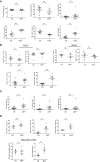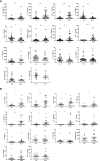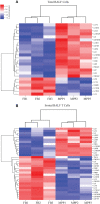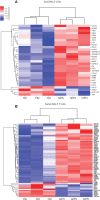Exhausted and Apoptotic BALF T Cells in Proinflammatory Airway Milieu at Acute Phase of Severe Mycoplasma Pneumoniae Pneumonia in Children
- PMID: 35111152
- PMCID: PMC8801936
- DOI: 10.3389/fimmu.2021.760488
Exhausted and Apoptotic BALF T Cells in Proinflammatory Airway Milieu at Acute Phase of Severe Mycoplasma Pneumoniae Pneumonia in Children
Abstract
Severe mycoplasma pneumoniae pneumonia (MPP) in children presents with serious clinical complications. Without proper and prompt intervention, it could lead to deadly consequences. Dynamics of the inflammatory airway milieu and activation status of immune cells were believed to be the hallmark of the pathogenesis and progress of the disease. In this study, by employing the T-cell sorting and mRNA microarray, we were able to define the main feature of the chemokine/cytokine expression and the unique characteristics of T cells in the bronchoalveolar lavage fluid (BALF) from severe MPP patients at acute phase. Our study for the first time delineated the molecular changes in isolated BALF T cells in severe MPP children with respect to the cytokine/chemokine expression, cell activation, exhaustion, and apoptosis. By comparing the BALF aqueous expression of cytokines/chemokines with that in sorted T cells, our data give a preliminary clue capable of finishing out the possible cell source of the proinflammatory cytokines/chemokines from the BALF mixture. Meanwhile, our data provide a distinctively pellucid expression profile particularly belonging to the isolated BALF T cells demonstrating that in the inflammatory airway, overactivated T cells were exhausted and on the verge of apoptotic progress.
Keywords: T cells; bronchoalveolar lavage fluid (BALF); cell exhaustion; children; mycoplasma pneumoniae pneumonia (MPP); proinflammatory milieu.
Copyright © 2022 Chen, Liu, Zheng, Kang, Wang, Mou, Zhang, Jiao, Zhao and Gui.
Conflict of interest statement
The authors declare that the research was conducted in the absence of any commercial or financial relationships that could be construed as a potential conflict of interest.
Figures







Similar articles
-
Increased T cell activation in BALF from children with Mycoplasma pneumoniae pneumonia.Pediatr Pulmonol. 2015 Aug;50(8):814-9. doi: 10.1002/ppul.23095. Epub 2014 Aug 26. Pediatr Pulmonol. 2015. PMID: 25157471
-
BALF editome profiling reveals A-to-I RNA editing associated with severity and complications of Mycoplasma pneumoniae pneumonia in children.mSphere. 2025 Mar 25;10(3):e0101224. doi: 10.1128/msphere.01012-24. Epub 2025 Feb 25. mSphere. 2025. PMID: 39998235 Free PMC article.
-
The correlation between the level of cellular classification in bronchoalveolar lavage fluid of children with severe Mycoplasma pneumoniae and clinical characteristics.Eur J Pediatr. 2024 Oct;183(10):4351-4362. doi: 10.1007/s00431-024-05700-6. Epub 2024 Aug 2. Eur J Pediatr. 2024. PMID: 39093423
-
Cytokines and refractory mycoplasma pneumoniae pneumonia in children: a systematic review.Minerva Pediatr (Torino). 2024 Apr;76(2):259-267. doi: 10.23736/S2724-5276.23.07158-6. Epub 2023 May 8. Minerva Pediatr (Torino). 2024. PMID: 37155205
-
[Deep lung--cellular reaction to HIV].Rev Port Pneumol. 2007 Mar-Apr;13(2):175-212. Rev Port Pneumol. 2007. PMID: 17492233 Review. Portuguese.
Cited by
-
Co-detection of respiratory pathogens in children with Mycoplasma pneumoniae pneumonia: a multicenter study.Front Pediatr. 2025 May 23;13:1482880. doi: 10.3389/fped.2025.1482880. eCollection 2025. Front Pediatr. 2025. PMID: 40487016 Free PMC article.
-
Extract with care: the imperative of rigor, transparency, and reproducibility in meta-analysis.Transl Pediatr. 2025 Jul 31;14(7):1733-1736. doi: 10.21037/tp-2025-337. Epub 2025 Jul 11. Transl Pediatr. 2025. PMID: 40800183 Free PMC article. No abstract available.
-
Predictive value of chemokines (CCL 2) in bronchoalveolar lavage fluid for refractory mycoplasma pneumonia in children.Ital J Pediatr. 2023 Sep 23;49(1):125. doi: 10.1186/s13052-023-01528-2. Ital J Pediatr. 2023. PMID: 37740208 Free PMC article.
-
miRNA, lncRNA and circRNA: targeted molecules with therapeutic promises in Mycoplasma pneumoniae infection.Arch Microbiol. 2023 Jul 21;205(8):293. doi: 10.1007/s00203-023-03636-3. Arch Microbiol. 2023. PMID: 37477725 Review.
-
Study on the Correlation Between the Expression of NF-Ƙb in the Alveolar Lavage Fluid of Children with Severe Mycoplasma Pneumoniae Pneumonia, Its Clinical Characteristics, and Cellular Immunity.Infect Drug Resist. 2024 Jun 19;17:2469-2484. doi: 10.2147/IDR.S411361. eCollection 2024. Infect Drug Resist. 2024. PMID: 38915319 Free PMC article.
References
-
- Koh YY, Park Y, Lee HJ, Kim CK. Levels of Interleukin-2, Interferon-Gamma, and Interleukin-4 in Bronchoalveolar Lavage Fluid From Patients With Mycoplasma Pneumonia: Implication of Tendency Toward Increased Immunoglobulin E Production. Pediatrics (2001) 107(3):E39. doi: 10.1542/peds.107.3.e39 - DOI - PubMed
Publication types
MeSH terms
Substances
LinkOut - more resources
Full Text Sources

